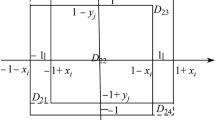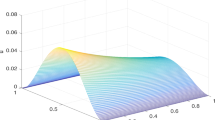Abstract
Tempered fractional Laplacian is the generator of the tempered isotropic Lévy process. This paper provides the finite difference discretization for the two-dimensional tempered fractional Laplacian by using the weighted trapezoidal rule and the bilinear interpolation. Then it is used to solve the tempered fractional Poisson equation with homogeneous Dirichlet boundary condition and the error estimate is also derived. Numerical experiments verify the predicted convergence rates and effectiveness of the schemes.




Similar content being viewed by others
References
Acosta, G., Bersetche, F.M., Borthagaray, J.P.: A short FE implementation for a 2D homogeneous Dirichlet problem of a fractional Laplacian. Comput. Math. Appl. 74, 784–816 (2017)
Acosta, G., Borthagaray, J.P.: A fractional Laplace equation: regularity of solutions and finite element approximations. SIAM J. Numer. Anal. 55, 472–495 (2017)
Applebaum, D.: Lévy Processes and Stochastic Calculus. Cambridge University Press, UK Cambridge (2009)
Axelsson, O.: Iterative Solution Methods. Cambridge University Press, UK Cambridge (1996)
Bogdan, K., Burdzy, K., Chen, Z.Q.: Censored stable process. Probab. Theory Relat. 127, 89–152 (2003)
Brenner, S.C., Scott, L.R.: The Mathematical Theory of Finite Element Methods. Texts in Applied Mathematics, New York (2008)
Buades, A., Coll, B., Morel, J.M.: Image denoising methods. A new nonlocal principle. SIAM Rev. 52, 113–147 (2010)
Chen, K.: Matrix Preconditioning Techniques and Applications. Cambridge University Press, UK Cambridge (2005)
Deng, W.H., Li, B.Y., Tian, W.Y., Zhang, P.W.: Boundary problems for the fractional and tempered fractional operators. Multiscale Model. Simul. 16, 125–149 (2018)
Deng, W.H., Wu, X.C., Wang, W.L.: Mean exit time and escape probability for the anomalous processes with the tempered power-law waiting times. EPL 117, 10009 (2017)
Duo, S.W., Wyk, H.W.V., Zhang, Y.Z.: A novel and accurate finite difference method for the fractional Laplacian and the fractional Poisson problem. J. Comput. Phys. 355, 233–252 (2018)
D’Elia, M., Gunzburger, M.: The fractional Laplacian operator on bounded domains as a special case of the nonlocal diffusion operator. Comput. Math. Appl. 66, 1245–1260 (2013)
Gunzburger, M., Li, B.Y., Wang, J.L.: Sharp convergence rates of time discretization for stochastic time-fractional PDEs subject to additive space-time white noise. Math. Comput. 88, 1715–1741 (2018)
Hilfer, R.: Applications of Fractional Calculus in Physics. World Scientific Publishing Co., New Jeasy (2000)
Huang, Y.H., Oberman, A.: Finite difference methods for fractional Laplacians. in press (arXiv:1611.00164v1. [math.NA])
Huang, Y.H., Oberman, A.: Numerical methods for the fractional Laplacian: a finite difference-quadrature approach. SIAM J. Numer. Anal. 52, 3056–3084 (2014)
Klafter, J., Sokolov, I.M.: Anomalous diffusion spreads its wings. Phys. world 18, 29–32 (2005)
Kwaśnicki, M.: Ten equivalent definitions of the fractional Laplace operator. Fract. Calc. Appl. Anal. 20, 7–51 (2015)
Mainardi, F., Raberto, M., Gorenflo, R., Scalas, E.: Fractional calculus and continuous-time finance II: the waiting-time distribtion. Phys. A. 287, 468–481 (2000)
Metzler, R., Klafter, J.: The random walk’s guide to anomalous diffusion: a fractional dynamics approach. Phys. Rep. 339, 1–77 (2000)
Mößner, B., Reif, U.: Error bounds for polynomial tensor product interpolation. Computing 89, 185–197 (2009)
Pozrikidis, C.: The Fractional Laplacian. CRC Press, London (2016)
Stein, E.M.: Singular Integrals and Differentiability Properties of Functions. Princeton University Press, New Jersey Princeton (1970)
Zhang, Z.J., Deng, W.H., Fan, H.T.: Finite difference schemes for the tempered fractional Laplacian. Numer. Math. Theor. Meth. Appl. 12, 492–516 (2019)
Zhang, Z.J., Deng, W.H., Karniadakis, G.E.: A Riesz basis Galerkin method for the tempered fractional Laplacian. SIAM J. Numer. Anal. 56, 3010–3039 (2018)
Author information
Authors and Affiliations
Corresponding author
Additional information
Communicated by Jan Hesthaven.
Publisher's Note
Springer Nature remains neutral with regard to jurisdictional claims in published maps and institutional affiliations.
This work was supported by the National Natural Science Foundation of China under Grant No. 12071195, the AI and Big Data Funds under Grant No. 2019620005000775, and the Fundamental Research Funds for the Central Universities under Grant No. lzujbky-2021-it26.
Appendices
Appendix
Numerically calculating \((\varDelta +\lambda )^{\frac{\beta }{2}}\) performed on a given function
According to the equation \(-(\varDelta +\lambda )^{\frac{\beta }{2}} u(x,y)=f(x,y)\), we can compute \(-(\varDelta +\lambda )^{\frac{\beta }{2}} u(x,y)\) to get the source term f(x, y). Since the singularity and non-locality of \(-(\varDelta +\lambda )^{\frac{\beta }{2}} u(x,y)\), one can’t directly approximate it by the trapezoidal rule. Now we provide the technique to calculate it. For a fixed point (x, y), we denote
Without loss of generality, we set \(\varOmega =(-1,1)\times (-1,1)\). For any \((x,y)\in \varOmega \), we denote \(A_1\) as a square whose length is \(2r_1\) and center point is (x, y) and \(A_2\) as a square whose length is \(2r_2\) and center point is (x, y). To compute the source term f(x, y), we divide the domain into four parts, i.e., \({\mathbb {R}}\times {\mathbb {R}}=({\mathbb {R}}\times {\mathbb {R}})\backslash A_1\bigcup (A_1\backslash \varOmega )\bigcup (\varOmega \backslash A_2)\bigcup A_2\), shown in Fig. 5.
For the term
since \(\mathbf{supp }~u(x,y)\subset \varOmega \), (A.1) can be rewritten as
Next, we establish polar coordinates at point (x, y) and let \(x-\xi =r\cos (\theta )\), \(y-\eta =r\sin (\theta )\). Then, by simple calculations, we can obtain
When \(\lambda =0\) for (A.2), we have
We just approximate it by the trapezoidal rule in a finite interval. When \(\lambda \ne 0\), we approximate (A.2) by the function ‘integral2.m’ in MATLAB.
For the term
using its symmetry leads to
Because of the weak singularity, we try to compute it in polar coordinates. Let \(\xi =r\cos (\theta )\), \(\eta =r\sin (\theta )\). Then (A.3) can be rewritten as
In (A.4), for some special function, such as \(u(x,y)=(1-x^2)^2(1-y^2)^2\), we can expand it as
For (A.4), the inner integration about r can be calculated analytically when \(\lambda =0\), so we approximate the outer integration about \(\theta \) by the trapezoidal rule; when \(\lambda \ne 0\), we can transform the inner integration about r to a nonsingular numerical integration by virtue of integration by parts.
For another two terms,
we get them by the trapezoidal rule directly.
Weights of approximating tempered fractional Laplacian
Rights and permissions
About this article
Cite this article
Sun, J., Nie, D. & Deng, W. Algorithm implementation and numerical analysis for the two-dimensional tempered fractional Laplacian. Bit Numer Math 61, 1421–1452 (2021). https://doi.org/10.1007/s10543-021-00860-5
Received:
Accepted:
Published:
Issue Date:
DOI: https://doi.org/10.1007/s10543-021-00860-5
Keywords
- Two-dimensional tempered fractional Laplacian
- The weighted trapezoidal rule
- Bilinear interpolation
- Error estimate





